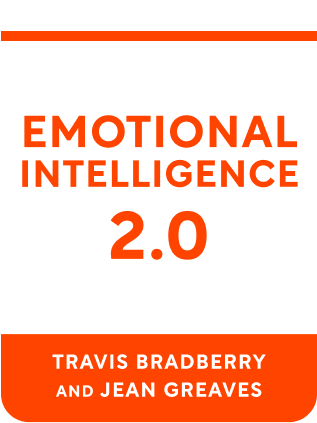

This article is an excerpt from the Shortform book guide to "Emotional Intelligence 2.0" by Travis Bradberry and Jean Greaves. Shortform has the world's best summaries and analyses of books you should be reading.
Like this article? Sign up for a free trial here .
Do you want to boost your emotional intelligence and become better at navigating social situations, no matter the context? What are some emotional intelligence strategies you can practice?
Emotional intelligence (EQ) is your ability to identify your own and others’ emotions and handle them effectively. Unlike IQ, EQ can be learned and trained. Travis Bradberry classifies emotional intelligence strategies into four groups: self-awareness, self-management, social awareness, and relationship management.
Keep reading for more about emotional intelligence strategies.
Emotional Intelligence Strategies
As much as our society values and admires intellect, it’s really your ability to navigate your emotional landscape and develop relationships with other people that opens doors in life. Since social interaction permeates all aspects of life, developing your emotional intelligence is vital to achieving success in any domain. But where do you even begin?
As with personality and intellect, emotional intelligence can be broken down into several domains: self-awareness, self-management, social awareness, and relationship management. Below are 32 emotional intelligence strategies to develop each of the four components.
Strategies to Develop Self-Awareness
Self-awareness is your ability to identify your emotions as they occur and recognize your tendencies during different scenarios. Practice these emotional intelligence strategies to develop your emotional self-awareness.
Strategy #1: Understand the physical effects of your emotions. Close your eyes and examine different physical factors such as your heartbeat, breath, and muscle tension. Then, recall a memory that elicits a strong emotional response. Notice the way your body changes based upon that emotion. Recognizing physical responses allows you to quickly identify your emotions in your day-to-day life.
Strategy #2: Find the reason behind your emotion. Emotions act as a guide, pointing out things in your psyche or surroundings that you may not recognize otherwise. Assess why you’re feeling what you’re feeling. This helps you resolve any problems or tensions that are causing unwanted feelings.
Strategy #3: Embrace discomfort. Avoiding painful feelings only creates a short-term solution and exacerbates problems further down the line. When an uncomfortable emotion emerges, dive into your feeling and work through it. Once you understand why you’re uncomfortable, you can handle the uncomfortable emotion more effectively.
Strategy #4: Don’t identify your emotions as “good” or “bad.” Emotions aren’t “good” or “bad.” Judging a feeling only puts more emotions (such as shame or pride) on top of that feeling. This keeps your original emotion from developing and muddies your current emotional state.
Strategy #5: Know your triggers. Everyone has people and behaviors that push their buttons. Knowing what triggers you allows you to strategize for those situations. Be specific when noting your triggers. Identify people, activities, and environments that irk you. Then, mentally prepare yourself for the situation.
Strategy #6: Be specific about the message you send to the world. The clothes you wear, your physical demeanor, and your facial expressions all send specific messages and usually reflect your internal emotions. Understand the message your demeanor and appearance sends. This will help you understand why people interact with you the way that they do.
Strategy #7: Invite feedback. When it comes to examining your behavior, you’re inherently biased. Reach out to other people to get a truly objective picture of yourself and the ways you respond to certain situations or people.
Strategies to Develop Self-Management
After you’ve strengthened your self-awareness skills, you can begin to practice emotional intelligence strategies for self-management. Self-management is the ability to use your self-awareness to manage your emotions and stay in control of your behavior.
Strategy #1: Focus on your breath. Your brain requires oxygen to function properly. Especially when stressed, people don’t breathe deeply enough, robbing the brain of valuable oxygen. When the brain lacks oxygen, it prioritizes basic needs (such as touch or sight) over complex processes (such as thought or emotion). When you take deep breaths, your rational brain engages and your body calms down.
Strategy #2: Develop a reason vs. emotion list. To make decisions clearer, make a two-column list. On one side, list what your emotional brain wants you to do, and, on the other, list what your rational brain wants you to do. Once you complete your list, compare the two sides and ask yourself two questions:
- Where is emotion warping my perspective?
- Where is rationality ignoring key information from my emotions?
Strategy #3: Take time before you react. If you respond to emotionally charged situations too quickly, your feelings become the driving force behind your words, and, often, lead you to say or do things that don’t align with your intentions. Instead, step away from the situation before responding. This gives you a clearer perspective on the situation and helps you make logical choices instead of emotional ones.
Strategy #4: Sleep better. Most people don’t sleep effectively, denying their brain a full recharge. Self-management requires focus, energy, and clarity—all of which rely on the brain working as efficiently as possible. To get restful sleep, turn off your electronics two hours before bed and only use your bed for sleeping.
Strategy #5: Schedule time to exercise. Exercise increases blood flow and overall fitness. It releases chemicals into your brain that help recharge your mental battery and strengthen areas of your brain that correlate to decision-making, rationality, and organization. Schedule specific time to commit to some form of physical activity and stick to it. Ideally, these activities should be active and vigorous, but any form of exercise will yield results.
Strategy #6: Publicize your goals. When creating goals for yourself, have other people hold you accountable. It’s much easier to abandon your goals when no one else knows about them. When you publicize your goals, the people around you will watch after you and help you make decisions to get you to achieve your objective.
Strategy #7: Keep your “self-talk” positive. “Self-talk” is your inner voice and has a major impact on your emotional state. If you keep your self-talk positive, it can get you through challenges and help support you throughout your day. However, if you let your self-talk become negative, it can ruin a good mood and quickly make your day miserable.
Strategies to Develop Social Awareness
Once you have the ability to understand and manage your own emotions, you can begin to develop social awareness. Social awareness is the ability to identify emotions in other people and understand the reasons behind them. Here are some emotional intelligence strategies to develop your social awareness.
Strategy #1: Listen attentively. Listening isn’t just about hearing words. Tone, volume, and pacing all signal subtext and emotion (for instance, if a person speaks quickly and quietly, they may be intimidated). Stay focused on the conversation at hand. Half-focused listening prevents you from picking up important information and makes the other person feel disrespected.
Strategy #2: Learn the rules of your environment. Learn how your company operates and what their expectations are. Also, learn the culture and background of your co-workers. If you don’t, you may find yourself at odds with your environment, making your job more difficult.
Strategy #3: Practice empathy. Looking at a situation from someone else’s point of view helps you understand their behaviors, gives you the tools to more effectively interact with that person, and identifies issues before they develop. When trying to step into someone else’s shoes:
- Think of how they’ve responded to specific situations in the past
- Consider their past experiences and background
- Observe how they behave in different environments
Strategy #4: Observe body language. Body language provides subtextual information that can reveal a person’s emotional state (for example, if someone can’t keep eye contact with you, they may be uncomfortable or lying). This allows you to make more informed decisions when interacting with them. Key emotional indicators include the behavior of someone’s eyes, the authenticity of their smile, and the tension in their body
Strategy #5: Live in the moment. Though reflecting on the past and planning for the future are both necessary exercises, allowing them to dictate your day-to-day behavior prevents you from observing and interacting with your surroundings. Keep your head clear by staying focused on the present moment. If you find yourself drifting mentally, try to snap yourself back. This will help you make more effective connections and deepen interactions with those around you.
Strategy #6: Make sure the time is right. If you make requests or observations at the wrong time, the person you’re speaking with likely won’t respond well. To ensure proper timing, keep the emotional state of the other person in mind. If they’re clearly angry or distraught, frame your question in a way that will not further upset them or find a better time to approach them with your issues.
Strategy #7: Read the room. Once you’ve mastered reading the emotions of individuals, you can start to catch onto the mood of entire rooms. This allows you to give your input in an appropriate and well-timed manner.
Strategies to Develop Relationship Management
Once you have a handle on your own emotions and can recognize the emotions of the people around you, you can begin to develop relationship management. Relationship management is the use of your self- and social awareness to develop your relationships with other people.
Strategy #1: Be open and take an interest. When you willingly share things about yourself, it clarifies why you behave the way that you do and minimizes the opportunity for misunderstanding. Also, taking an interest in the lives of others helps you understand their choices and ensures that you don’t misinterpret their behaviors.
Strategy #2: Embrace feedback. Having someone point out errors or areas of improvement can lead to intense emotional responses. However, feedback is essential to development and requires that you hear it without letting your emotions get in the way. Think about the purpose of the feedback, listen attentively, and take time to process the information.
Strategy #3: Improve your communication style. Your natural style of communication dictates how others perceive you. If the way you talk does not reflect your intentions, others may not understand what you’re trying to communicate and may misjudge you. For example, if you typically state things bluntly, people may think that you’re rude, even if your intention is just to be clear. Think about the upsides and downsides of the way you currently communicate and adjust your approach accordingly.
Strategy #4: Explain your choices. People fear what they don’t understand. If you leave people in the dark, they may not understand why you’ve made a decision, leading to frustration and/or anxiety. When explaining your decision, acknowledge any alternative routes, show your thought process, then explain the ways your decision will impact everyone.
Strategy #5: Respect the emotions of others. If you try to negate or ignore what they’re feeling, they won’t respond well. Use your listening skills, ask what you can do to help, and be empathetic. This validates how the person is feeling without exaggerating or exacerbating their emotional state.
Strategy #6: Show your appreciation. Little shows of appreciation can go a long way. When someone does good work, praise them. When they go the extra mile, acknowledge it. Even if it’s something as small as buying someone lunch or leaving a thank you note, small gestures let the people around you know that you see the work that they’re doing and that you appreciate it.
Strategy #7: Respond appropriately. This requires you to read the situation, recognize the emotions of the other person, and assure them that you believe what they’re feeling is important.

———End of Preview———
Like what you just read? Read the rest of the world's best book summary and analysis of Travis Bradberry and Jean Greaves's "Emotional Intelligence 2.0" at Shortform .
Here's what you'll find in our full Emotional Intelligence 2.0 summary :
- What emotional intelligence is and why it's essential for your workplace success
- The 4 reasons you need to work on your EQ
- How you can use EQ to better manage relationships






